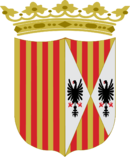Catherine of Aragon
| Catherine of Aragon | |
|---|---|
 |
|
| Catherine of Aragon when a widow, by Michael Sittow c.1505[1] | |
|
|
|
| Tenure | 11 June 1509 – 23 May 1533 |
| Coronation | 24 June 1509 |
| Spouse | Arthur, Prince of Wales m. 1501; dec. 1502 Henry VIII of England m. 1509; ann. 1533 |
|
Among others...
Issue |
|
| Henry, Duke of Cornwall Mary I of England |
|
| House | House of Trastámara (by birth) House of Tudor (by marriage) |
| Father | Ferdinand II of Aragon |
| Mother | Isabella I of Castile |
| Born | 16 December 1485 Archbishop's Palace, Alcalá de Henares, Madrid |
| Died | 7 January 1536 (aged 50) Kimbolton Castle, Cambridgeshire |
| Signature | |
| Religion | Catholic |
Catherine of Aragon (Spanish: Catalina de Aragón) (16 December 1485 – 7 January 1536), also known as Katherine or Katharine, was Queen of England as the first wife of King Henry VIII of England and Princess of Wales as the wife to Arthur, Prince of Wales. In 1507, she also held the position of Ambassador for the Spanish Court in England when her father found himself without one, becoming the first female ambassador in European history.[2] For six months, she served as Queen Regent of England while Henry VIII was in France. During that time the English won the Battle of Flodden, an event in which Catherine played an important part. The controversial book "The Education of Christian Women" by Juan Luis Vives, which claimed women have the right to an education, was dedicated to and commissioned by her. Such was Catherine's impression on people, that even her enemy, Thomas Cromwell, said of her "If not for her sex, she could have defied all the heroes of History."[3] William Shakespeare described her as "The Queen of Earthly Queens"[4], and during her early years as queen consort she was described as "The most beautiful creature in the world."[5] She successfully appealed for the lives of the rebels involved in the Evil May Day for the sake of their families.[6]. Furthermore, Catherine won widespread admiration by starting an extensive programme for the relief of the poor.[7] She was also a patron of Renaissance humanism, and a friend of the great scholars Erasmus of Rotterdam and Saint Thomas More.
Henry VIII's move to have their 24-year marriage annulled set in motion a chain of events that led to England's break with the Roman Catholic Church. Henry was dissatisfied because their sons had died in infancy and others were stillborn, leaving their daughter, the future Mary I of England, as heiress presumptive, at a time when there was no established precedent for a woman on the throne, although there was no Salic law in England. When Pope Clement VII refused to annul the marriage, Henry defied him by assuming supremacy over religious matters. This allowed him to marry Anne Boleyn on the judgement of clergy in England, without reference to the Pope. He was motivated by the hope of fathering a male heir to the Tudor dynasty. Catherine refused to accept Henry as Supreme Head of the Church of England and considered herself, as did most of England and Europe, the King's rightful wife and Queen until her death.
Early life
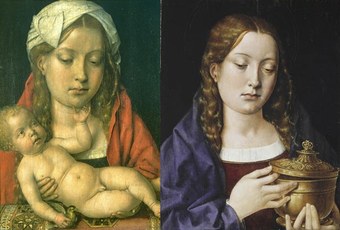
Catherine was born at the Archbishop's Palace in Alcalá de Henares near Madrid, on the night of 16 December 1485. She was the youngest surviving child of King Ferdinand II of Aragon and Queen Isabella I of Castile. Catherine was quite short in stature[9] with long golden auburn hair, wide blue eyes, a round face, and a fair complexion.[10] She was descended, on her maternal side, from the English royal house as her great-grandmother Catherine of Lancaster, after whom she was named, and her great-great-grandmother Philippa of Lancaster, were both daughters of John of Gaunt and granddaughters of Edward III of England. Consequently she was third cousin of her father-in-law, Henry VII, and fourth cousin of her mother-in-law Elizabeth of York.
She was educated by a tutor, Alessandro Geraldini, who was a clerk in Holy Orders. Catherine studied religion, the classics, Latin histories, canon and civil law, heraldry, and genealogy. She had a strong religious upbringing and developed a faith that would play a major role in later life.[11] She learned to speak, read and write in Spanish and Latin, and spoke French and Greek. She was also taught domestic skills, such as needlepoint, lace-making, embroidery, music and dancing.[12] The great scholar Erasmus would later say that Catherine "loved good literature which she had studied with success since childhood".[13]
At an early age, she was considered a suitable wife for Arthur, Prince of Wales, the eldest son of Henry VII of England and heir to the throne, due to her overwhelmingly prominent English ancestry inherited from her mother Queen Isabella I of Castile. By means of her mother, Catherine had a stronger legitimate ancestry to the English throne via the two first wives of John of Gaunt, 1st Duke of Lancaster; Blanche of Lancaster and the Spanish Infanta Constance of Castile, by whom John had hoped to claim the Crown of Castile. On the other hand Henry VII of England was the descendant of Gaunt's third marriage to Katherine Swynford, whose children were born out of wedlock and only legitimized after the death of Constance and the marriage of John to Katherine. The children of John and Katherine, while legitimized, were barred from ever inheriting the English throne. Because of this, the Tudor monarchy was not accepted by all the European kingdoms. At the time, the house of Trastamara was the most prestigious, due to the great rule of the Catholic Monarchs, so the alliance of Catherine and Arthur validated the House of Tudor in the eyes of European royalty and also strengthened the Tudor claim to the English throne via Catherine of Aragon's ancestry. It would also have given a male heir an indisputable claim to the throne. The two were married by proxy on 19 May 1499, and corresponded in Latin until Arthur turned fifteen and it was decided that they were old enough to be married.
Faith
Catherine was a member of the Spanish order of Observant Franciscans and was punctilious in her religious observations, integrating without demur her necessary duties as queen with her personal piety. The outward celebration of saints and holy relics formed no part of her personal devotions,[14] which she rather expressed in mass, prayer, confession and penance. Privately, however, she was aware of what she identified as the shortcomings of the papacy and church officialdom.[14] Her doubts about church improprieties certainly did not extend so far as to support the allegations of corruption made public by Martin Luther in Wittenberg in 1517, which were soon to have such far-reaching consequences in initiating the protestant reformation: In 1523 Fray Alfonso de Villa Sancta, a learned friar of the Observant Franciscans and friend of the king's old advisor Erasmus, dedicated to the queen his book De Liberio Arbitrio adversus Melanchthonem denouncing Philipp Melanchthon, a supporter of Luther. Acting as her confessor, he was able to nominate her as a "Defender of the Faith" for denying Luther's arguments.[15]
Appearance
Catherine was of a very fair complexion, had blue eyes, and had a hair colour that was between reddish-blonde and auburn; these were typical in members of the Trastámara family who were descendants of Peter I of Castile. During her lifetime she was described as "The most beautiful creature in the world", and that there was "Nothing lacking in her that the most beautiful girl should have." Saint Thomas More would reflect later in her lifetime that in regards to her appearance "There were few women who could compete with the Queen [Catherine] in her prime."
As wife and widow of Arthur
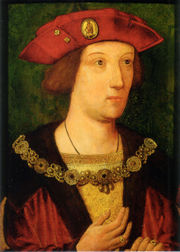
The couple later met on 4 November at Dogmersfield in Hampshire. Little is known about their first impressions of each other, but Arthur did write to his parents-in-law that he would be 'a true and loving husband' and told his parents that he was immensely happy to 'behold the face of his lovely bride'. They found that they were unable to speak to each other since they had learned different pronunciations of Latin.[16] Ten days later, on 14 November 1501, they were married at St. Paul's Cathedral.
Once married, Arthur was sent to Ludlow Castle on the borders of Wales, to preside over the Council of Wales and the Marches, as was his duty as Prince of Wales, and his bride accompanied him. The couple stayed in Castle Lodge, Ludlow A few months later, they both became ill, possibly with the sweating sickness which was sweeping the area. He died on 2 April 1502, and she almost died too, but recovered to find herself a widow.
At this point, Henry VII faced the challenge of avoiding returning her dowry to her father. To avoid complications, it was agreed she would marry Henry VII's second son, Henry, Duke of York, who was five years younger than she was. However, the death of her mother meant that Catherine's 'value' in the marriage market decreased. Castile was a much larger kingdom than Aragon and it was inherited by Catherine's mentally unstable elder sister, Joanna. Ostensibly, the marriage was delayed until Henry was old enough, but Henry VII procrastinated so much about Catherine's unpaid dowry that it was doubtful if the marriage would ever take place. She lived as a virtual prisoner at Durham House in London.[17] Some of her letters to her father, complaining of her treatment, have survived. In one of these letters she tells him that "I choose what I believe, and say nothing. For I am not as simple as I may seem." She had little money and struggled to cope, as she had the wellbeing of her ladies-in-waiting to maintain as well as her own. In 1507 she served as the Spanish Ambassador for England, thus becoming the first female ambassador in European history[18]. While Henry VII and his councillors expected her to be easily manipulated, Catherine went on the prove them wrong.[18]
Marriage to Arthur's brother depended on the Pope granting a dispensation because canon law forbade men to marry their brother's widows. Catherine testified her marriage to Arthur was never consummated, as also according to canon law, a marriage is not valid until consummated. The matter was considered of minor importance at the time, as the Pope had the power to overrule any objections, whether or not they were for religious reasons.
Queen of England (1509-1533)
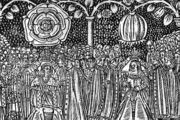
Catherine's second wedding took place on 11 June 1509, seven years after Prince Arthur's death. She married the then recently succeeded Henry VIII in a private ceremony at Greenwich Church. She was 23 years of age. The king was just days short of his 18th birthday.
Coronation
On Saturday 23 June, the traditional eve-of-coronation procession to Westminster was greeted by a large and enthusiastic crowd. As was the custom, they spent the night before their coronation at the Tower of London. On Midsummer's Day, Sunday, 24 June 1509, Henry VIII and Catherine of Aragon were anointed and crowned together by the Archbishop of Canterbury at a lavish ceremony at Westminster Abbey. The coronation was followed by a banquet in Westminster Hall. Many new Knights of the Bath were created in honour of the coronation.
Pregnancies and children
On 31 January 1510, Catherine gave birth prematurely to a stillborn daughter. A son, Henry, Duke of Cornwall, was born on New Year's Day 1511. He lived for only 52 days. In 1513, Catherine was pregnant again. Henry appointed her regent when he went to France on a military campaign. When the Scots invaded, they were defeated at the Battle of Flodden Field, with Catherine addressing the army, and riding north in full armour with some of the troops, despite being heavily pregnant at the time. She sent a letter to Henry along with the bloodied coat of the King of Scots, James IV, who died in the battle.
Catherine had lost another son when Henry returned from France. He was either stillborn or died shortly after birth. In November 1514, she had another stillborn son. On 18 February 1516, Catherine delivered a healthy girl. She was named Mary and christened three days later with great ceremony at the Church of Observant Friars. In 1518, Catherine became pregnant for the last time. She gave birth to a daughter on 10 November, but the child was weak and lived only a few hours. Catherine was pregnant six times altogether.

Catherine's religious dedication increased as she aged, as did her interest in academics. She continued to broaden her knowledge and provide training for her daughter. Education among women became fashionable, partly because of Catherine's influence. She also donated large sums of money to several colleges. Henry, however, still considered a male heir essential. The Tudor dynasty was new, and its legitimacy might still be tested. A long civil war (1135–54) had been fought the last time a woman, (Henry I of England's daughter, Empress Matilda), had inherited the throne. The disasters of civil war were still fresh in living memory from the Wars of the Roses.
In 1520, Catherine's nephew Charles V, Holy Roman Emperor, paid a state visit to England, and she urged Henry to enter an alliance with Charles rather than with France. Immediately after his departure, she accompanied Henry to France on the celebrated visit to Francis I, the so-called Field of the Cloth of Gold. Within two years, war was declared against France and the Emperor was once again welcome in England, where plans were afoot to betroth him to Catherine's daughter Mary.
The King's Great Matter
| The Six Wives of Henry VIII |
|---|

In 1525, Henry VIII became enamoured of Anne Boleyn, a maid-of-honour to Queen Catherine who was between 10 and 17 years younger than Henry (Anne's exact year of birth is unknown). Henry began pursuing her.[19] By this time Catherine was no longer able to bear children. Henry began to believe that his marriage was cursed and sought confirmation from the Bible, which he interpreted to say that if a man marries his brother's wife, the couple will be childless.[20] Even if her marriage to Arthur had not been consummated (and Catherine would insist, to her dying day, that she had come to Henry's bed a virgin), Henry's interpretation of that Biblical passage meant that their marriage had been wrong in the eyes of God. Whether the Pope at the time of Henry and Catherine's marriage had had the right to overrule Henry's claimed scriptural impediment would become a hot point in Henry's campaign to wrest an annulment from the present Pope. It is possible that the idea of annulment had been suggested to Henry much earlier than this, and is highly probable that it was motivated by his desire for a son. Before Henry's father, Henry VII, ascended the throne, England was beset by civil warfare over rival claims to the English crown, and Henry may have wanted to avoid a similar uncertainty over the succession.[21]
| “ | My tribulations are so great, my life so disturbed by the plans daily invented to further the King's wicked intention, the surprises which the King gives me, with certain persons of his council, are so mortal, and my treatment is what God knows, that it is enough to shorten ten lives, much more mine. | ” |
It soon became the one absorbing object of Henry's desires to secure an annulment.[22] Catherine was defiant when it was suggested that she quietly retire to a nunnery, saying "God never called me to a nunnery, I am the King's true and legitimate wife".[23] He set his hopes upon an appeal to the Holy See, acting independently of Cardinal Thomas Wolsey, whom he told nothing of his plans. William Knight, the King's secretary, was sent to Pope Clement VII to sue for an annulment, on the grounds that the dispensing bull of Pope Julius II was obtained by false pretences.
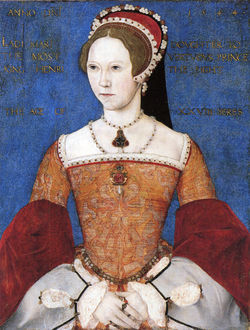
As the Pope was, at that time, the prisoner of Catherine's nephew, Emperor Charles V, following the Sack of Rome in May 1527, Knight had difficulty in obtaining access to him. In the end, Henry's envoy had to return without accomplishing much. Henry now had no choice but to put his great matter into the hands of Thomas Wolsey, and Wolsey did all he could to secure a decision in Henry's favour.[24] Wolsey went so far as to convene an ecclesiastical court in England, with a representative of the Pope presiding, and Henry and Catherine herself in attendance. Shakespeare's play, The Famous History of the Life of King Henry the Eighth accurately records Catherine's astounding coup in that remarkable courtroom in Act II, scene iv. She bows low to Henry, puts herself at his mercy, states her case with irrefutable eloquence and then sweeps out of the courtroom, a woman both formidable and clearly wronged. The Pope had no intention of allowing a decision to be reached in England, and his legate was recalled. (How far the pope was influenced by Charles V is difficult to say, but it is clear Henry saw that the Pope was unlikely to annul his marriage to the Emperor's aunt.[25]) The Pope forbade Henry to marry again before a decision was given in Rome. Wolsey had failed and was dismissed from public office in 1529. Wolsey then began a secret plot to have Anne Boleyn forced into exile and began communicating with the Pope, to that end. When this was discovered, Henry ordered Wolsey's arrest and, had he not been terminally ill and died in 1530, he might have been executed for treason.[26] A year later, Catherine was banished from court, and her old rooms were given to Anne Boleyn. When Archbishop of Canterbury William Warham died, the Boleyn family's chaplain, Thomas Cranmer, was appointed to the vacant position.[27]
When Henry decided to annul his marriage to Catherine, John Fisher became her most trusted counsellor and one of her chief supporters. He appeared in the legates' court on her behalf, where he shocked people with the directness of his language, and by declaring that, like John the Baptist, he was ready to die on behalf of the indissolubility of marriage. Henry was so enraged by this that he wrote a long Latin address to the legates in answer to Fisher's speech. Fisher's copy of this still exists, with his manuscript annotations in the margin which show how little he feared Henry's anger. The removal of the cause to Rome ended Fisher's role in the matter, but Henry never forgave him. Other people who supported Catherine's case included Thomas More, Henry's own sister Mary Tudor, Queen of France, Maria de Salinas, Charles V of Germany, Pope Paul III and Protestant Reformers Martin Luther and William Tyndale.
Later years
|
|||||||||||||||||||||
Upon returning to Dover from a meeting with King Francis I of France in Calais, Henry married Anne Boleyn in a secret ceremony. Whilst some sources claim that Anne was probably already pregnant at the time, one of the aspects that made her most attractive to Henry, was the fact that she refused to sleep with him until they were married. On Anne's side, she had seen what Henry had done to her sister, Mary Boleyn, and her unwillingness to be his mistress was part of her plan. Some considered Henry's marriage to Anne false being supporters of Catherine. If Catherine's marriage to Arthur was consummated, Henry VIII by canon law had right to remarry.[28] On 23 May 1533, Cranmer, sitting in judgment at a special court convened at Dunstable Priory to rule on the validity of Henry's marriage to Catherine, declared the marriage illegal. Five days later, on 28 May 1533, Cranmer declared the marriage of Henry and Anne valid.[29]
Until the end of her life, Catherine would refer to herself as Henry's only lawful wedded wife and England's only rightful queen; her faithful servants continued to address her by that title. However, Henry refused her the right to any title but "Dowager Princess of Wales", in recognition of her position as his brother's widow.
In 1535 she was transferred to the decaying and remote Kimbolton Castle. Confining herself to one room, leaving it only to attend Mass, and fasting most of the time, and wearing the hair shirt of the Order of St. Francis, she prepared to meet her end. While she was permitted to receive occasional visitors, she was forbidden to see her daughter, Mary. They were also forbidden to communicate but discreet sympathizers ferried letters between mother and daughter. Henry offered them both better quarters and each other's company if they would acknowledge Anne Boleyn as his new Queen. Neither did.
In late December 1535, sensing death was near, she made her will, and wrote to her nephew, the Emperor Charles V, asking him to protect her daughter. She then penned one final letter to Henry, her "most dear lord and husband"[30]:
My most dear lord, King and husband,The hour of my death now drawing on, the tender love I ouge [owe] thou forceth me, my case being such, to commend myselv to thou, and to put thou in remembrance with a few words of the healthe and safeguard of thine allm [soul] which thou ougte to preferce before all worldley matters, and before the care and pampering of thy body, for the which thoust have cast me into many calamities and thineselv into many troubles. For my part, I pardon thou everything, and I desire to devoutly pray God that He will pardon thou also. For the rest, I commend unto thou our doughtere Mary, beseeching thou to be a good father unto her, as I have heretofore desired. I entreat thou also, on behalve of my maides, to give them marriage portions, which is not much, they being but three. For all mine other servants I solicit the wages due them, and a year more, lest they be unprovided for. Lastly, I makest this vouge [vow], that mine eyes desire thou aboufe all things.
Katharine the Quene.
She died at Kimbolton Castle, on 7 January 1536. The following day, news of her death reached the King. According to the chronicler Edward Hall, Anne wore yellow for the mourning, which has been interpreted in various ways; Polydore Vergil interpreted this to mean that Anne did not mourn.[31] However, Chapuys reported that it was actually King Henry who decked himself in yellow, celebrating the news and making a great show of his and Anne's daughter, Elizabeth, to his courtiers.[32] This was seen as distasteful and vulgar by many. Another theory, is that the dressing in yellow was out of respect for the late queen-princess dowager as yellow was the Spanish colour of mourning. Certainly, later in the day it is reported that Henry and Anne both individually and privately wept for her death. On the day of Catherine's funeral, Anne Boleyn miscarried a son, which led to her execution a few months later. Rumours then circulated that Catherine had been poisoned by Anne or Henry, or both, as Anne had threatened to murder both Catherine and Mary on several occasions. The rumours were born after the apparent discovery during her embalming that there was a black growth on her heart that might have been caused by poisoning.[33] Modern medical experts are in agreement that her heart's discolouration was due not to poisoning, but to cancer, something which was not understood at the time.
Catherine was buried in Peterborough Cathedral with the ceremony due to a Dowager Princess of Wales, not a queen. Henry did not attend the funeral and refused to allow Mary to attend either.
Legacy, memory, and historiography
In the reign of her daughter, Mary I of England, her marriage to Henry VIII was declared "good and valid." Her daughter Queen Mary I also had several portraits commissioned of Catherine, and it would not by any means be the last time she was painted. After her death, numerous portraits were painted of her, particularly of her speech at the Legatine Trial, a moment accurately rendered in Shakespeare's play about Henry VIII.
Her tomb in Peterborough Cathedral can be seen and there is hardly ever a time when it is not decorated with flowers or pomegranates, her heraldic symbol. It bears the title Katharine Queen of England.
In the 20th century, George V's consort, Queen Mary had her grave upgraded and there are now banners there denoting Catherine as a Queen of England. Every year at Peterborough Cathedral there is a service in her memory. There are processions, prayers, and various events in the Cathedral including processions to Catherine's grave in which candles, pomegranates, flowers and other offerings are placed on her grave. On the service commemorating the 470th anniversary of her death, the Spanish Ambassador to the United Kingdom attended. The service started with a procession, led by the Mayor, from the Peterborough town hall, invited guests then joined the parade en route, before taking up their position in the Cathedral, music was played by pupils from the King's School, and a trumpeter heralded the start of the procession, then as they entered the Cathedral, music was played from the restored organ. After the service, people were able to view portraits of Catherine of Aragon drawn by local schoolchildren for an art competition, which the ambassador then judged. During the 2010 service a rendition of Katharine of Aragon's speech before the legatine court was read by Jane Lapotaire. There is a statue of her in her birthplace of Alcalá de Henares, as a young woman holding a book and a rose.[34]
Catherine has remained a popular biographical subject to the present day. The American historian Garrett Mattingly was the author of a popular biography Katherine of Aragon in 1942. In 1966, Catherine and her many supporters at court were the subjects of Catherine of Aragon and her Friends, a biography by John E. Paul. In 1967, Mary M. Luke wrote the first book of her Tudor trilogy, Catherine the Queen which portrayed her and the controversial era of English history through which she lived.
In recent years, the historian Alison Weir covered her life extensively in her biography The Six Wives of Henry VIII, first published in 1991. Antonia Fraser did the same in her own 1992 biography of the same title; as did the British historian David Starkey in his 2003 book Six Wives: The Queens of Henry VIII.[35][36][37] Giles Tremlett's biography "Catherine of Aragon: The Spanish Queen of Henry VIII" came out in 2010, and Julia Fox's biography of Catherine of Aragon will be released in 2011.
Places and Statues
- In Alcalá de Henares, the place of Catherine's birth, a statue of Catherine as a young woman holding a rose and a book can be in the Archbishop's Palace.
- Peterborough is twinned with the Castilian city of Alcalá de Henares. Children from schools in the two places have learned about each other as part of the twinning venture, and artists have even come over from Alcalá de Henares to paint Catharine's tombstone.
- Aragon in Ampthill is named after Catherine, there is also in Ampthill a statue of a cross named "Queen Catherine's Cross" in her honour.
Spelling of her name
Her baptismal name was "Catalina", but "Katherine" was soon the accepted form in England after her marriage to Arthur.[14] Katherine herself signed her name "Katherine", "Katherina", "Katharine" and sometimes "Katharina". In a letter to her, Arthur, her first husband, addressed her as "Princess Katerine". Her daughter Queen Mary I called her "Quene Kateryn", in her will. Rarely were names, particularly first names, written in an exact manner during the sixteenth century and it is evident from Catherine's own letters that she endorsed different variations.[38] Loveknots built into his various palaces by her husband, Henry VIII, display the initials "H & K", as do other items belonging to Henry and Katherine, including gold goblets, a gold salt cellar, basins of gold, and candlesticks. Her tomb in Peterborough Cathedral is marked "Katharine Queen of England".[39]
Titles, styles and arms
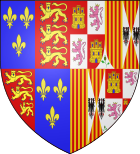
- 16 December 1485 – 14 November 1501: Infanta Catalina of Castile and Aragon
- 14 November 1501 – 2 April 1502: The Princess of Wales, Duchess of Cornwall, Countess of Chester [41]
- 2 April 1502 – 11 June 1509: The Dowager Princess of Wales, Dowager Duchess of Cornwall, Dowager Countess of Chester[42]
- 11 June 1509 – 23 May 1533: Her Grace The Queen of England
- 23 May 1533 – 7 January 1536: Her Highness The Dowager Princess of Wales, Dowager Duchess of Cornwall, Dowager Countess of Chester [42][45]
In art and media
Over the years, numerous artistic and cultural works have been dedicated to her, written about her, or mentioned her, including some by her husband Henry VIII, who wrote "Grene growth the holy" about and for her, and Juan Luis Vives, who dedicated "The Education of Christian Women" to her.[46]
Catherine of Aragon has been portrayed in film, television, plays, books, and other forms many times, and as a result she has stayed very much in popular memory. There has never been a film or television series where she is the main character although an arguable exception is the first episode of The Six Wives of Henry VIII which is told from her point of view and where she is portrayed by Annette Crosbie. There are also many novels, songs, and poems written about her. Shakespeare's play Henry VIII is tremendously successful in recreating, with great accuracy, Katherine's statement about the legitimacy of her marriage at the court in Blackfriars before King Henry, and Katherine's portrayal is very sympathetic therein. However, most of the rest of the play is an attempt to absolve many, especially Henry VIII, and the timing of key incidents (including Katherine's death) are changed and other events are avoided (the play makes Henry nearly an innocent pawn in the hands of a dastard Cardinal Wolsey, and the play stops short of Anne Boleyn's execution).
Although Katherine is often portrayed in film and on stage as having possessed the stereotypical Spanish traits of dark hair and eyes and an olive complexion, existing portraits and contemporary descriptions depict her as having had blue eyes, fair skin, and reddish-blonde hair, not unusual for Spaniards such as those from her father's land of Aragon. She is often played with a Spanish accent; from most reports, this is accurate, as she never fully mastered the English language.
Furthermore, she was part English, through her ancestors, Katherine of Lancaster and Philippa of Lancaster, who were both daughters of John of Gaunt, 1st Duke of Lancaster.
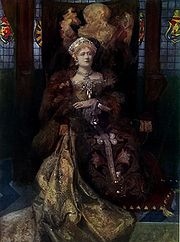
Music and rhymes
- The song "Green groweth the holly" is said to have been written for her by Henry VIII.
- In the children's nursery rhyme "I had a little nut tree" she is the "King of Spain's Daughter".
- She is remembered in a street ballad, for vouching for the rioters, on behalf of their wives and children, after the Evil May Day.
Books
Catherine is the main character in:
- "Katharine, The Virgin Widow", "The Shadow of the Pomegranate", and "The King's Secret Matter" (later published in an omnibus "Katharine of Aragon") by Jean Plaidy
- The King's Pleasure, by Norah Lofts;
- "The Constant Princess", by Philippa Gregory (a novel about Catherine's younger years);
- "Patience, Princess Catherine" by Carolyn Meyer (young adult novel);
- "Isabella's Daughter" by Charity Bishop.
Catherine is a character in:
- "Murder Most Royal", by Jean Plaidy;
- "The Trusted Servant" by Alison Macleod
- "The Other Boleyn Girl" by Philippa Gregory (a novel about Mary Boleyn's life)
- The Dark Rose, Volume 2 of The Morland Dynasty, by Cynthia Harrod-Eagles
- "Wolf Hall" by Hilary Mantel
Theatre, Film, Stage, and TV
Catherine was portrayed by:
- Sarah Siddons in the 18th century, in Shakespeare's Henry VIII. She told Samuel Johnson that the role of Queen Catherine was her favourite of all the Shakespearean roles she had played, as it was "the most natural".[47]
- Violet Vanbrugh in the 1911 short film production of William Shakespeare's play Henry VIII (first film portrayal).
- German actress Hedwig Pauly-Winterstein in the film "Anna Boleyn".
- Rosalie Crutchley in "The Sword and the Rose", an account of Mary Tudor's romance with the Duke of Suffolk in 1515. (Crutchley later played Henry's sixth queen Katherine Parr in The Six Wives of Henry VIII.).
- Greek actress Irene Pappas in Hal B. Wallis' acclaimed film Anne of the Thousand Days.
- Frances Cuka in the 1973 film "Henry VIII and his Six Wives". Keith Michell reprised his role as Henry VIII. A scene was incorporated between Frances Cuka and Charlotte Rampling (playing Anne Boleyn) to show their quiet, glacial enmity.
- Claire Bloom in a 1979 adaptation of Shakespeare's "Henry VIII".
- British actress Annette Crosbie in a 90-minute television drama entitled "Catherine of Aragon", the first part of the BBC series "The Six Wives of Henry VIII".
- Annabelle Dowler in Dr. David Starkey's 2001 documentary series on Henry VIII's Six Wives.
- Spanish actress Yolanda Vasquez, a brief appearance in the British TV version "The Other Boleyn Girl" (January 2003), opposite Jared Harris as Henry VIII and Natascha McElhone as Mary Boleyn.
- Assumpta Serna in the October 2003 ITV two-part television drama, "Henry VIII" which starred Ray Winstone in the title role. Part 1 chronicled the king's life from the birth of his bastard son, Henry Fitzroy until the execution of Anne Boleyn in 1536. David Suchet co-starred as Cardinal Wolsey.
- Maria Doyle Kennedy in the Showtime 2007 television series, "The Tudors" opposite Jonathan Rhys Meyers as Henry. For her performance, Kennedy won an IFTA Award for Best Actress in a Supporting Role Television, and a Gemini Award for an Actress in a Featured Supporting Role in a Dramatic Series.
- Ana Torrent in the 2007 film adaptation of the novel "The Other Boleyn Girl" by Philippa Gregory, with Eric Bana as Henry VIII.
- Virginia Weeks portrayed her in the play "Six Dead Queens and an Inflatable Henry", and is one of only three productions that show Catherine with the correct colouring.
- In 2008 she was played by Victoria Pelro in the film "The Twisted Tale of Bloody Mary".
- She is played by Siobhan Hewitt in the 2009 documentary Henry: Mind of a Tyrant. This documentary is one of the few portrayals of Catherine to get her appearance correct.
- Kate Duchêne in a 2010 adaptation of Shakespeare's "Henry VIII" at Shakespeare's Globe Theatre.
Ancestry
| Ancestors of Catherine of Aragon | ||||||||||||||||||||||||||||||||||||||||||||||||||||||||||||||||||||||||||||||||||||||||||||||||||||||||||||||||||||||||||||||||||||||||||||||||||||||||||||||||||||||||||||||||||||||||||||||||||||||||||||||||||||||||||||||||||||||||||||||||||||||||||||||||||||||||||||||||||||||||||||||||||||||||||||||||||||||||||||||||||||||||||||||||||||||||||||||||||||||||||||||||||||||||||||||||||||||||||||||||||||||||||||||||||||||||||||||||||||||||||||||||||||||||||||||||||||||||||||||||||||||||||||||||||||||||||||||||||||||||||||||||||||||||||||||||||
|---|---|---|---|---|---|---|---|---|---|---|---|---|---|---|---|---|---|---|---|---|---|---|---|---|---|---|---|---|---|---|---|---|---|---|---|---|---|---|---|---|---|---|---|---|---|---|---|---|---|---|---|---|---|---|---|---|---|---|---|---|---|---|---|---|---|---|---|---|---|---|---|---|---|---|---|---|---|---|---|---|---|---|---|---|---|---|---|---|---|---|---|---|---|---|---|---|---|---|---|---|---|---|---|---|---|---|---|---|---|---|---|---|---|---|---|---|---|---|---|---|---|---|---|---|---|---|---|---|---|---|---|---|---|---|---|---|---|---|---|---|---|---|---|---|---|---|---|---|---|---|---|---|---|---|---|---|---|---|---|---|---|---|---|---|---|---|---|---|---|---|---|---|---|---|---|---|---|---|---|---|---|---|---|---|---|---|---|---|---|---|---|---|---|---|---|---|---|---|---|---|---|---|---|---|---|---|---|---|---|---|---|---|---|---|---|---|---|---|---|---|---|---|---|---|---|---|---|---|---|---|---|---|---|---|---|---|---|---|---|---|---|---|---|---|---|---|---|---|---|---|---|---|---|---|---|---|---|---|---|---|---|---|---|---|---|---|---|---|---|---|---|---|---|---|---|---|---|---|---|---|---|---|---|---|---|---|---|---|---|---|---|---|---|---|---|---|---|---|---|---|---|---|---|---|---|---|---|---|---|---|---|---|---|---|---|---|---|---|---|---|---|---|---|---|---|---|---|---|---|---|---|---|---|---|---|---|---|---|---|---|---|---|---|---|---|---|---|---|---|---|---|---|---|---|---|---|---|---|---|---|---|---|---|---|---|---|---|---|---|---|---|---|---|---|---|---|---|---|---|---|---|---|---|---|---|---|---|---|---|---|---|---|---|---|---|---|---|---|---|---|---|---|---|---|---|---|---|---|---|---|---|---|---|---|---|---|---|---|---|---|---|---|---|---|---|---|---|---|---|---|---|---|---|---|---|---|---|---|---|---|---|---|---|---|---|---|---|---|---|---|---|---|---|---|---|---|---|---|---|---|---|---|---|---|---|---|---|---|---|---|---|---|---|---|---|---|---|---|---|---|---|---|---|---|---|---|---|---|---|---|---|---|---|---|---|---|---|---|---|---|---|---|---|---|---|---|---|---|---|---|---|---|---|---|---|---|---|---|---|---|---|---|---|---|---|---|---|---|---|---|---|---|---|---|---|---|---|---|---|---|---|---|---|---|---|---|
|
||||||||||||||||||||||||||||||||||||||||||||||||||||||||||||||||||||||||||||||||||||||||||||||||||||||||||||||||||||||||||||||||||||||||||||||||||||||||||||||||||||||||||||||||||||||||||||||||||||||||||||||||||||||||||||||||||||||||||||||||||||||||||||||||||||||||||||||||||||||||||||||||||||||||||||||||||||||||||||||||||||||||||||||||||||||||||||||||||||||||||||||||||||||||||||||||||||||||||||||||||||||||||||||||||||||||||||||||||||||||||||||||||||||||||||||||||||||||||||||||||||||||||||||||||||||||||||||||||||||||||||||||||||||||||||||||||
See also
- List of English consorts
- Descendants of Isabella I of Castile and Ferdinand II of Aragon
Notes
- ↑ The Six Wives of Henry VIII, by Alison Weir. Page 28
- ↑ The Six Wives of Henry VIII by Alison Weir. Page 59
- ↑ Eustace Chapuys, Imperial Ambassador, 1533 Calendar of State Papers, Spanish, IV, ii, 737
- ↑ William Shakespeare's 'All is True', Act II, Scene IV
- ↑ The Six Wives of Henry VIII, by Alison Weir. Page 81.
- ↑ Contemparies of Erasmus, by Peter G. Bietenholz & Thomas B. Deutscher. Page 283.
- ↑ Contemparies of Erasmus, by Peter G. Bietenholz & Thomas B. Deutscher. Page 283.
- ↑ Six Wives of Henry VIII, by Alison Weir. Page 28
- ↑ Antonia Fraser,The Wives of Henry VIII', p.24
- ↑ Alison Weir, The Six Wives of Henry VIII,15
- ↑ Antonia Fraser, The Wives of Henry VIII',p.12
- ↑ Weir, p.20
- ↑ Maria Dowling, Humanism in the age of Henry VIII(Published 1986), p.17
- ↑ 14.0 14.1 14.2 Davies, C. S. L.; Edwards, John (January 2008), "Katherine (1485–1536)", Oxford Dictionary of National Biography, Oxford, England: Oxford University Press, doi:10.1093/ref:odnb/4891, "Katherine seems not to have displayed the credulity so often associated with the cults of saints, nor to have been concerned with such manifestations of devotion as the collection of holy relics. She had a keen eye for the failings of churchmen, including those of popes and cardinals."
- ↑ Fraser, Antonia (1992), The Six Wives of Henry VIII (2002 ed.), London: Phoenix, p. 95, ISBN 1842126334
- ↑ Antonia Fraser, The Wives of Henry VIII', p.25
- ↑ Williams, p.15
- ↑ 18.0 18.1 Six Wives of Henry VIII, Alison Weir. Page 59.
- ↑ Scarisbrick, p.154.
- ↑ Leviticus 20:21
- ↑ Lacey, p.70.
- ↑ Brigden, p.114.
- ↑ Farquhar, Michael (2001). A Treasure of Royal Scandals, p.61. Penguin Books, New York. ISBN 0-7394-2025-9.
- ↑
 "Henry VIII" in the 1913 Catholic Encyclopedia.
"Henry VIII" in the 1913 Catholic Encyclopedia. - ↑ Morris, p.166.
- ↑ Haigh p.92f
- ↑
 "Clement VII" in the 1913 Catholic Encyclopedia.
"Clement VII" in the 1913 Catholic Encyclopedia. - ↑ Starkey, pp. 462–464.
- ↑ Williams, p.124.
- ↑ Sharon Turner, The History of England from the Earliest Period to the Death of Elizabeth (Longman, Rees, Orme, Brown and Green,1828)
- ↑ Warnicke, p. 187.
- ↑ Warnicke, p. 188.
- ↑ Lofts, p.139.
- ↑ Catalina de Aragon on Flickr - Photo Sharing!
- ↑ Starkey, David, "Six Wives: The Queens of Henry VIII" Part I
- ↑ Weir, Alison, "The Six Wives of Henry VIII" Part I
- ↑ Fraser, Antonia, "The Six Wives of Henry VIII" Part I
- ↑ Catherine's endorsement of different spellings can be identified in numerous letters, signing herself as 'Katharine the Quene' in a letter to Wolsey in 1513 and as 'Katharine' in her final letter to Henry VIII, dating to Jan 1536.
- ↑ Antonia Fraser, The Six Wives of Henry VIII, pages 57-58
- ↑ Maclagan, Michael; Louda, Jiří (1999), Line of Succession: Heraldry of the Royal Families of Europe, London: Little, Brown & Co, pp. 27, ISBN 0-85605-469-1
- ↑ As spouse of the Prince of Wales, Katherine held the titles of Princess of Wales, Duchess of Cornwall, and Countess of Chester.
- ↑ 42.0 42.1 As a widow, she was Dowager Princess of Wales, Dowager Duchess of Cornwall, and Dowager Countess of Chester.
- ↑ The Six Wives of Henry VIII, Alison Weir. Pages 114-116
- ↑ Around 1519 Henry VIII decided Majesty should become the style of the Kings and Queens of England. "Majesty", however, was not used exclusively; it arbitrarily alternated with both "Highness" and "Grace", even in official documents.
- ↑ Since Katherine never acknowledged the annulment of her marriage, she styled herself as Queen until her death.
- ↑ Alison Weir,The Six Wives of Henry VIII', p.123
- ↑ Boswell, James. Life of Samuel Johnson. May 1783.
- ↑ 48.0 48.1 Lundy, Darryl, thePeerage, http://www.thepeerage.com/p10588.htm#i105871, retrieved 2007-10-25
- ↑ 49.0 49.1 Lundy, Darryl, thePeerage, http://www.thepeerage.com/p11347.htm#i113464, retrieved 2007-10-25
- ↑ 50.0 50.1 Lundy, Darryl, thePeerage, http://www.thepeerage.com/p329.htm#i3286, retrieved 2007-10-25
- ↑ She was the daughter John of Gaunt, 1st Duke of Lancaster to his first wife Blanche of Lancaster, making her half-sister of Katherine of Aragon's maternal great-grandmother Katherine of Lancaster, daughter of John of Gaunt, 1st Duke of Lancaster to his second wife Constance of Castile.
- ↑ Lundy, Darryl, thePeerage, http://www.thepeerage.com/p11433.htm#i114328, retrieved 2007-10-25
References
- Brigden, Susan (2000). New Worlds, Lost Worlds.
- Fraser, Antonia (1992). The Wives of Henry VIII. ISBN 0-679-73001-X
- Haigh, Christopher (1993) English Reformations.
- J.O. Hand & M. Wolff, (1986) Early Netherlandish Painting, National Gallery of Art, Washington(catalogue)/Cambridge UP, 1986, ISBN 0-521-34016-0
- Lacey, Robert (1972) The Life and Times of Henry VIII.
- Lofts, Norah (1979) Anne Boleyn. ISBN 0-698-11005-6.
- Morris, T. A. (1998) Europe and England in the Sixteenth Century.
- Starkey, David (2003). Six Wives: The Queens of Henry VIII. ISBN 0-06-000550-5
- Warnicke, Retha M. (1991). The Rise and Fall of Anne Boleyn. ISBN 0-521-40677-3
- Weir, Alison (1991). The Six Wives of Henry VIII. ISBN 0-8021-3683-4
- Williams, Neville (1971) Henry VIII and his Court.
- Mattingly, Gareth (1941) Catherine of Aragon
- John E. Paul (1996) Catherine of Aragon and her friends
Further reading
- Mattingly, Garrett. (1941). Katherine of Aragon.
- Lindsey, Karen. (1995). Divorced Beheaded Survived: A Feminist Reinterpretation of the Wives of Henry VIII. ISBN 0-201-40823-6
- Coates, Tim. (2001) Letters of Henry VIII 1526-29.
- Ashley, Mike (2002). British Kings & Queens. ISBN 0-7867-1104-3
- Weir, Alison. (2002). Henry VIII: The King and His Court. ISBN 0-345-43708-X
- Starkey, David. (2003) Six Wives: The Queens of Henry VIII.
- Bernard, G.W. (2005) The King's Reformation: Henry VIII and the Remaking of the English Church.
- Tremlett, Giles (2010) Catherine of Aragon: The Spanish Queen of Henry VIII
External links
- Catherine of Aragon's divorce papers and other Tudor treasures online to mark the 500th anniversary of Henry VIII's accession
- Catherine of Aragon at Find a Grave
- tudorhistory.org - An overview of her life, accompanied by a portrait gallery
- englishhistory.net - An in-depth look at her life and times
- A geo-biography of the Six Wives of Henry the VIII on Google Earth
- Guardian unlimited, letter from her to Pope Clement VII
- Katharine of Aragon.com - An Official Website For Her Cause
|
Catherine of Aragon
House of Trastámara
Born: 16 December 1485 Died: 7 January 1536 |
||
| English royalty | ||
|---|---|---|
| Vacant
Title last held by
Elizabeth of York |
Queen consort of England Lady of Ireland 11 June 1509 – 23 May 1533 |
Vacant
Title next held by
Anne Boleyn |
|
||||||||||||||||||||||||||||||||||||||||||||||||||||||||
|
|||||
|
|||||
